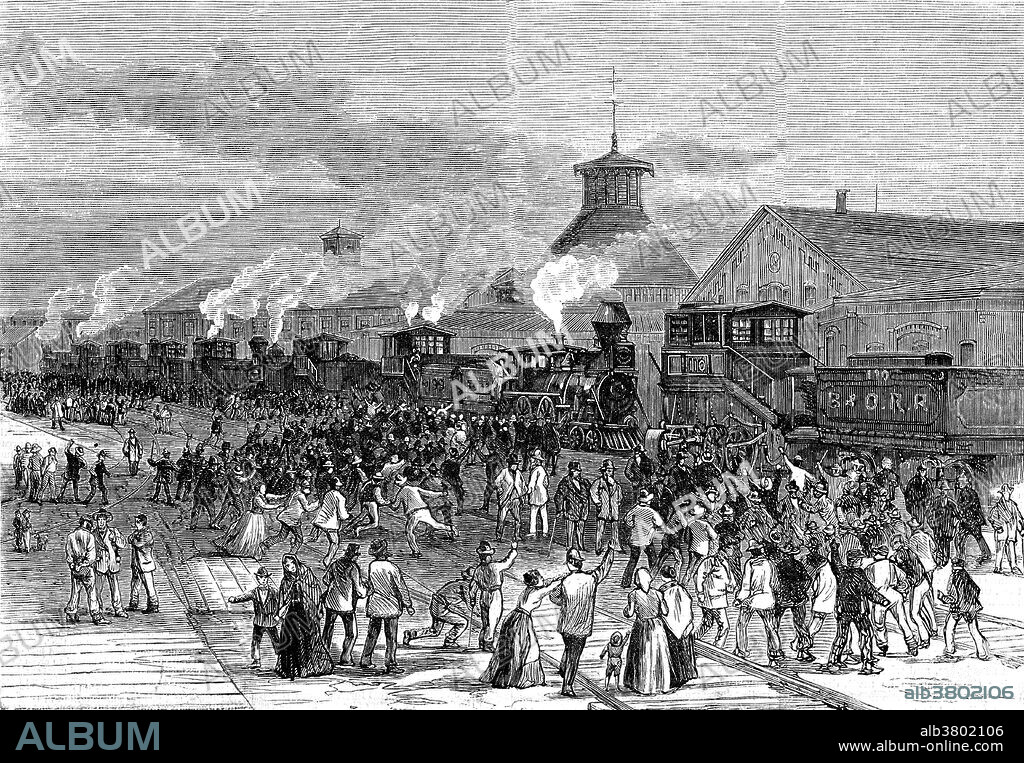alb3802106
Great Railroad Strike, 1877

|
Add to another lightbox |
|
Add to another lightbox |



Title:
Great Railroad Strike, 1877
Caption:
The Great Railroad Strike of 1877 started in response to the cutting of wages by the Baltimore & Ohio Railroad (B&O). Striking workers would not allow any of the stock to roll until this wage cut was revoked. The governor sent in state militia units to restore train service, but the soldiers refused to use force against the strikers. The strike spread to Cumberland, Maryland, stopping freight and passenger traffic. When Governor Carroll directed the 5th and 6th Regiments of the National Guard to put down the strike, citizens from Baltimore attacked the militia who then killed 10 and wounded 25. In Pittsburgh, militiamen bayoneted and fired on rock-throwing strikers, killing 20 and wounding 30 others. The strikers forced the militiamen to take refuge in a railroad roundhouse, and then set fires that razed 39 buildings and destroyed 104 locomotives and 1,245 freight and passenger cars. After over a month of constant rioting and bloodshed, President Rutherford B. Hayes sent in federal troops to end the strikes. These troops suppressed strike after strike, until at last, approximately 45 days after it had started, the Great Railroad Strike of 1877 was over.
Credit:
Album / Science Source / New York Public Library
Releases:
Model: No - Property: No
Rights questions?
Rights questions?
Image size:
4800 x 3329 px | 45.7 MB
Print size:
40.6 x 28.2 cm | 16.0 x 11.1 in (300 dpi)
Keywords:
1877 • 19TH CENTURY • AMERICA • AMERICAN • ART • ARTWORK • B&O • BALTIMORE & OHIO RAILROAD • BLOCKADE • BW • CELEBRITIES • CELEBRITY • CHILD • CHILDREN • CROWD • CROWDED • CUTTING OF WAGES • DRAWING • ENGINE • EVENT • EVENTS • FAMOUS PEOPLE • FAMOUS • FEMALE • GREAT RAILROAD STRIKE • GREAT UPHEAVAL • HARPER'S WEEKLY • HISTORIC • HISTORICAL • HISTORY • ILLUSTRATION • ILLUSTRATIONS • IMPORTANT • INDUSTRIAL LOCKOUT • MALE • MARTINSBURG • MEN • MULTITUDE • NOTABLE • RAILROAD STRIKE • RAILROAD WORKERS • RAILROAD • RUSH (CROWD) • STRIKE ACTION • STRIKE • STRIKERS • THRONG • TRAIN • UNITED STATES • US • USA • WALKOUT • WELL-KNOWN • WEST VIRGINIA • WOMAN • WOMEN • WORKERS
 Pinterest
Pinterest Twitter
Twitter Facebook
Facebook Copy link
Copy link Email
Email

